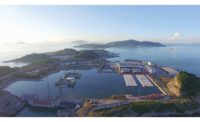Eurasia Tunnel
Istanbul
Best Project
Owner Avrasya Tuneli Isletme Insaat ve Yatırım A.S. (ATAS)
Contractor Yapı Merkezi İnşaat ve Sanayi A.Ş. & SK Engineering & Construction Co. Ltd. Joint Venture
Lead Designer, Civil Engineer Parsons Brinckerhoff
MEP Engineer SE-NAZ Proje Mühendislik Müşavirlik San. Tic. Ltd. Şti.
Consultant Ove Arup
TBM Manufacturer Herrenknecht
Located beneath the Bosporus in one of the world’s most seismically active areas, the first-ever roadway tunnel connecting Asia and Europe is set to open in late December—nearly a year ahead of the original schedule. Named “Yildirim Bayezid” for an Ottoman Empire-era sultan, a 13.7-meter-dia tunnel-boring machine excavated almost 500,000 cu m in less than two years.
The Turkish-South Korean joint-venture team building the $1.25-billion, 14.6-kilometer new route in Istanbul used expertise from Europe, Asia and the U.S., including Herrenknecht’s delivery of a TBM that project team members say ranks first in the world in terms of power per cutterhead area, at 33.3 kW/m², along with an operating pressure of 12 bar. Herrenknecht engineers designed a cutting wheel that is accessible from the rear of the 120-m-long, 330-tonne TBM while under atmospheric pressure. During excavation, crews replaced the scrapers 85 times and the rock disc cutters 440 times, says Başar Arioğlu, chairman of Yapi Merkezi Construction Inc.
Divers performed four hyperbaric interventions in a specialized shuttle. They worked at pressures as high as 10.5 bar, after which the workers required two weeks of decompression. Despite the extreme conditions, the project recorded 17.4 accidents per one million working hours, four times lower than the international industry average, with no significant injuries or deaths.
The 3,340-m-long tunnel section of the route required more than 15,000 pieces of 60-centimeter-thick precast segments that formed 1,672 rings for the tunnel diameter of 13.2 m. Designed for a service life of 100 years, the segments were later evaluated as lasting 126 years, despite the location at 106.4 m below sea level.
Crews also built cut-and-cover transition boxes on the Asian and European sides of the strait, plus 950 m of twin mined tunnels underneath a densely populated area. Some 1.3 million tons of muck from tunnel construction were repurposed for reclamation of abandoned mines around Istanbul to add much-needed green space for the crowded city.
In addition to meeting U.S. fire-safety standards, the tunnel is expected to meet functional standards in 500-year seismic events and safety standards for 2,500-year seismic events, thanks in part to double-sealed, rubber-gasketed seismic joint rings, manufactured by Japan’s Seibu Polymer Corp. and installed at strategic spots.
In a first for Turkey, international banks largely funded the road, which will operate under a 29-year build-operate-transfer contract. The team promised the lenders to shorten construction to 48 from 55 months. Now, it may be only 45 months.
Project officials say the new highway route will save 38 million liters of fuel a year and collectively save Istanbul motorists 52 million hours a year. A 100-minute commute now will take just 15.







